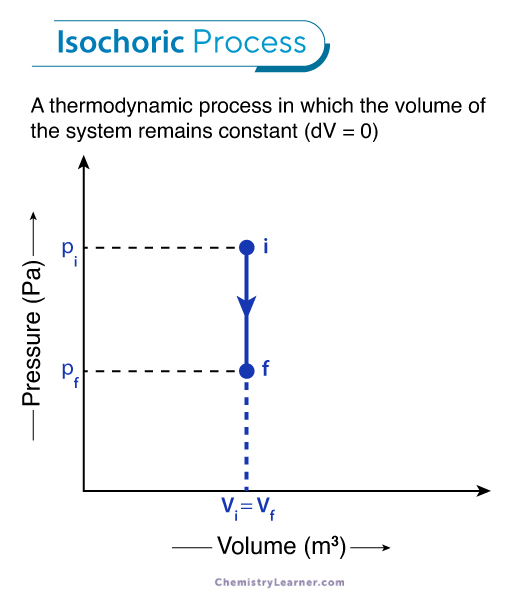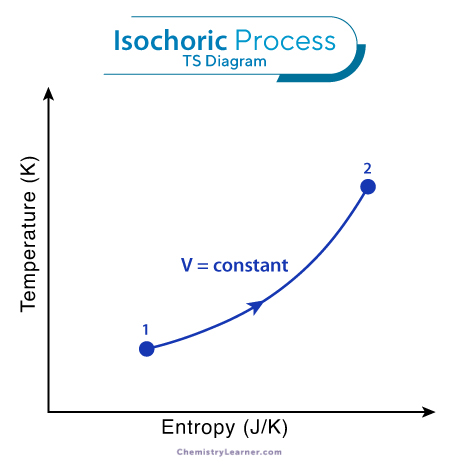Isochoric Process
An isochoric process is a thermodynamic process occurring at a constant volume. It is also known as an isometric, isovolumetric, or constant-volume process. The term isochoric comes from the Greek words iso, meaning equal, and choric, meaning place or volume.
This process is reversible as the process is slow enough to retain internal equilibrium at every step.
Examples
Some examples of isochoric processes in daily life are:
- The ideal Otto cycle in internal combustion engines, in which the burning of the gasoline-air mixture increases the engine’s pressure and temperature while the volume remains unchanged.
- A gas stored in a sealed cylinder expands and contracts with temperature fluctuations keeping its volume constant.
Work Done In an Isochoric Process
The work done in a closed system is calculated by integrating the area under the p-V graph. A straight vertical line on the diagram, called an isochor, represents an isochoric process. The area covered by it is 0, which means there is no work done by or on the system during the process.
Mathematically, this is derived as
W = ∫pdV
or W = or, W = p ΔV
or, W = p (Vf -Vi)
Where
Vi: initial volume of the gas
Vf: final volume of the gas
Since the volume remains unchanged, we get
ΔV = 0
Therefore, W = 0
In isochoric conditions, only heat transfer can occur, and there is no change in volume during expansion or contraction. Thus, there is no pressure-volume work done, and only the internal energy of the system changes.
Heat Transfer and Internal Energy in Isochoric Process
From the first law of thermodynamics, we get the relation between the internal energy of a system (ΔU), the heat transferred during the process (Q), and the work done (W). Thus, we have
ΔU = ΔQ – ΔW
Here, ΔW = p ΔV, known as boundary work. Putting this in the expression above,
ΔU = ΔQ – p ΔV
Since there is no work done on or by the system, based on the first law of thermodynamics
∆U = ∆Q
The expression for enthalpy change is given as
H = U + pV
As ΔV = 0, the expression becomes
ΔH = ΔU = ΔQ
Hence, all the heat transferred to or from the system contributes to a change in internal energy. Based on the ideal gas model, the internal energy is:
ΔU = TΔS = m cv ΔT
Where,
Cv: specific heat capacity at constant volume
m: mass of the gas
ΔT: change in temperature
ΔS: change in entropy
Since the change in internal energy occurs solely due to heat transfer, we can state that for ΔU > 0, ΔT > 0. Using this relation in the ideal gas law, we get
ΔP = (nR/V)ΔT
Where
n: number of moles of the gas
R: gas constant
Putting (nR/V) as a constant, we derive a relation between the pressure and temperature in an isochoric process as
pi/pf = Ti/Tf
Thus, an increase in the temperature accompanies an increase in the gas pressure at constant volume in a closed system.
Substituting this relation in the equation for heat transfer derived from entropy, we have
ΔQ = mcvTi(pf/pi – 1)
Where
Ti: initial temperature of the gas
Pi: initial pressure of the gas
Pf: final pressure of the gas
Example Problems
Problem 1: In a sealed container, 0.1 moles of monoatomic gas are kept at 27°C. The container is then heated to 500K. Evaluate the work done and the change in the internal energy of the gas. (R = 8.315 J/mol.K)
Solution:
Given: n = 0.1 mol Ti = 27°C + 273 = 300K Tf = 500K R = 8.315 J/mol.K
For an isochoric process, ΔV = 0. Therefore there is no work done. From the first law of thermodynamics, we then get
ΔU = ΔQ
For a monoatomic gas, internal energy will thus be
ΔU = 3/2nRΔT = 3/2nR(Tf – Ti)
= 3/2 (0.1 mol)(8.315 J/mol.K)(500K – 300K)
= 3/2 (0.1 mol)( 8.315 J/mol.K)(200K)
ΔU = 249.45 J
Problem 2: 2 kg of water is heated from 50°C to 80°C in a closed vessel. What will be the change in the internal energy of the water? (specific heat of water = 4184 J/kg.K)
Solution:
Given: mass of water = 2 kg Ti = 50°C = 323K Tf = 80°C = 353K cv = 4184 J/kg.K
In an isochoric process, work done is 0. Hence the internal energy is only dependent on the heat absorbed. Thus,
ΔU = ΔQ = mcvΔT
= 2 kg × 4184 J/kg.K × (353K – 323K)
= 2 kg × 4184 J/kg.K × 30K
ΔU = 251.04 kJ







